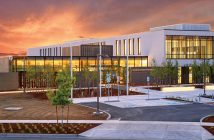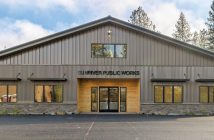
New ODOT Building Streamlines Project Delivery Operations for Region
A new 21,100 square foot Oregon Department of Transportation (ODOT) administrative building in Bend is paving the way for streamlined operations connected with critical statewide infrastructure projects.
The Project Delivery Building, built by general contractor CS Construction on the ODOT campus off North Highway 97, now consolidates a breadth of previously scattered expertise under one roof, merging staff of Region 4 – which includes the Central Oregon area – into one facility.
Transportation chiefs say the move will enhance internal communication and collaboration and improve logistical efficiency, as well as providing future savings by relocating around 57 employees that were housed in five different outlying buildings, including leased facilities off OB Riley Road.
An added boost in transitioning out of rental payment scenarios is that taxpayers are now also provided with a capital facility which will realize cost savings of some $3.1 million over the course of 25 years, and be able to accommodate up to close to 85 employees.
The new building is located in a corner of the ODOT campus just north of the existing Region 4 headquarters south of Empire Avenue and consolidates some nine departments under one roof.
The two-story building designed by BBT Architects also uses state-of-the-art practices for efficient energy use and work environment, and is designed to meet LEED (Leadership in Energy and Environmental Design) silver or higher equivalent and Oregon’s SEED (State Energy Efficiency Design) criteria.
The LEED approach establishes standards and design check-lists to ensure that buildings are designed and built using strategies intended to improve performance in energy savings, water efficiency, CO2 emissions reduction, improved indoor environmental quality, stewardship of resources and sensitivity to their impacts.
LEED was originally established in 1991 as a program, codified in state law, directing state agencies to work with the Oregon Department of Energy to ensure cost-effective energy conservation measures (ECMs) be included in new construction projects and major renovations to public buildings. Leased buildings are also required to be more energy efficient.
The law was revised in 2001 to require that all state facilities constructed on or after June 30, 2001, exceed the energy conservation provisions of the Oregon State Building Code by at least 20 percent. Existing buildings were also required to reduce energy use by 20 percent compared to the building’s baseline energy use in 2000, with energy conservation and efficiency projects in existing buildings allowed to be funded through energy savings performance contracts.
Funding for the budgeted $5.5 million Project Delivery Building in Bend was provided by the state Co-Location Capital Construction program, leveraged by the significant savings gained by eliminating the monthly payments that were being made on rental properties previously housing staff off site.
“We’ve been challenged over quite some time, with the many inefficiencies of being spread out and separated from each other having presented logistical, efficiency and cost impacts to the Region, particularly the Project Delivery business line and how they carry out their mission,” commented ODOT Area Manager Gary Farnsworth.
“The new building not only brings all of our project crews under one roof for improved project delivery, it also allows us to have staff from our various business lines brought closer together, for better coordination and overall customer service.”
Oregon Department of Transportation (ODOT) is responsible for the entire lifecycle of transportation improvement projects on the state highway system. This includes program development, project development, awarding construction contracts, construction management and maintenance, with the first four stages collectively known as project delivery.
Project delivery begins with planning and analysis and ends when the project is constructed. Each stage has components that include activities and products, with several business functions overlapping the activities throughout the process
The project-delivery group includes planners, engineers, geologists, biologists, geotechnical and environmental specialists, regulatory compliance and community relations employees, as well as functions such as property acquisition and oversight of financial aspects of the Statewide Transportation Improvement Program (STIP).
STIP is Oregon’s four-year transportation capital improvement program and the document that identifies the funding for, and scheduling of, transportation projects and programs. It includes projects on the federal, state, city and county transportation systems, multimodal projects (highway, passenger rail, freight, public transit, bicycle and pedestrian) and projects in the National Parks, National Forests and Indian tribal lands.
Farnsworth added, “This scenario is much more efficient and productive in terms of both project delivery and long range planning.
“Project delivery is probably most recognizable by capital improvement programs such as upgrades or major renovations of the highway system, but it encompasses a multitude of operations and a range of disciplines including civil engineering, roadway design, geology and environmental expertise.
“It also incorporates the passing of funds through to local jurisdictions and local program administration, so you can see there are a lot of moving parts and there is a benefit to improving communications under one roof.
“I was involved in the design process from the early stages and there was a lot of investment put into ergonomics and sustainability, offering new opportunities for employee commute-options, wellness and organizational health and safety benefits. We also now have features such as an enclosed secure building for bicycles, lockers and showers.
“Another nice feature of the new facility is the amount of conference space we now have, which means we have the capacity to bring a lot of people together, including for use in public interaction and in conjunction with other organizations within the community and state.
“We also have employed up-to-date audio-visual technology, which creates a lot of versatility, and recently were able to host a video conference including participants from across the country.
“We paid a lot of attention to creating a healthy work environment and sustainability, especially in terms of energy efficiency, while the functional building design reflects a sensible expenditure of public funds which is also a key part of ODOT’s mission.
“We think the new facility fits in sympathetically with the existing campus and reflects the land use and livability values of the local community.
“The building also exemplifies Central Oregon by including design elements that reflect the climate, culture and local materials in the area and I think the overall project was a great example of an all-round team effort yielding a great end product.”
The construction type is a two-story wood frame building with an exposed beam and column system and a masonry veneer, with exterior diagonal glue lam beams offering both interesting architectural relief and shading opportunity.
Project Architect Al Levage, a senior associate with BBT Architects, said initial design discussions included input from several user groups representing various fields, resulting in different iterations being presented that distillated into the final product.
The building has a solid, low maintenance construction basis while incorporating a high degree of functionality and many elements of sustainability, including polished concrete flooring, precast concrete stair treads and standing seam metal roof, which provides a more traditional appearance.
The flexible space includes a movable partition in the large main ground floor conference room, prominent use of recycled materials and extensive natural light, with some private offices and much open architecture and break-out rooms housing multiple departments.
An innovative Variable Refrigerant Flow (VRV) HVAC system has been installed, which provides considerable savings on energy, costs and space requirements. The VRV’s cutting edge inverter technology and heat recovery system supports separate heating and cooling in different rooms, making the system ideal for the constantly changing occupancy of a typical building, and its use for ventilation dramatically boosts energy efficiency.
The building also features a 9.2 kilowatt roof-mounted south-facing solar array comprised of 40 x 230-watt modules installed by Bend’s E2 Solar, and produced by Solar World – the largest US manufacturer of its type, based in Hillsboro, Oregon. It is estimated the array could produce some 12,500 kilowatt hours of power per year.
Another significant sustainability feature is the use of permeable pavers in the parking lot.
The somewhat experimental technology aims to reduce stormwater runoff by reducing impervious surfaces and using crushed concrete to provide a drainage layer beneath the permeable pavement surfaces.
The permeable paving employs sustainable materials and techniques with a base and sub base that allow the movement of stormwater through the surface. In addition to reducing runoff, this effectively traps suspended solids and filters pollutants from the water, with pervious materials allowing stormwater to percolate and infiltrate the surface areas, traditionally impervious to the soil below.
The goal is to control stormwater at the source, reduce runoff and improve water quality by filtering pollutants in the substrata layers.
Other exterior features include photo cell parking lot lights, native landscaping and secure parking.
Levage added, “We had great team involved with a clear idea of what goals were to be achieved, and the end result is an efficient, sustainable state building that creates a modern work environment and will stand the test of time in the long-term.”
ODOT Region 4 Delivery Building
63055 N Highway 97, Bend • 541-388-6467
Property Owner/Developer: Oregon Dept. of Transportation
Contractor: CS Construction
Project Cost: $4.1 Million
Square Footage: 21,100
CS Project Manager: Mike Rodgers
Supervisor: Alan Molene
Project Manager: Matt Cohen
Superintendent: Alan Mollere
Architect: Al Levage / BBT Architects
Principal Architect: Todd Turner
Structural Engineer: Froelich Engineers
Civil Engineer: WHPacific
Electrical/Mechanical Engineer: MFIA Inc. Consulting Engineers
Landscaping: WHPacific
Subcontractors and Suppliers:
AM-l Roofing, Inc., Aurora Painting, Inc., Daley Construction Co., Inc., Gowdy Brothers Electric, Inc., McKenzie Waterproofing, Inc., Mike’s Fence Center, Inc. North Country Building Specialties LLC, Overhead Door Co. of Central Oregon, Inc. Severson Fire Protection, Inc. Ultra Quiet Floors, Western Protective Coatings, LLC, J.T. Plumbing, ThyssenKrupp Elevator Corp., JKD Construction, Inc.. Moye’s Drywall, Superior Interiors, Inc., Latham Excavation, Old World Cobblestone, Inc., ConSeal, Inc., Alpine Glass, Aspen Ridge Electric, Inc., Cleaning Unlimited, Action Pride Cabinetry, Inc., Baldwin Custom Welding & Designs, Inc., E2 Powered, LLC, KA Veltman Concrete LLC, Central Oregon Heating and Cooling, Interior Tech, Davidson’s Masonry, Inc., 7 Peaks Paving LLC, Energy Conservation Insulation Co., Inc. MAX Manufacturing, Inc. , Barnes Quality Pest Control, Dave Gerhadt Tile, Povery & Associates, Ashland Medford Plumbing, Inc., Green Thumb Industries, Inc. Thomas Kay Textiles, Lyon Workspace Products, Dannick Corp., Lou S Building Specialties.




